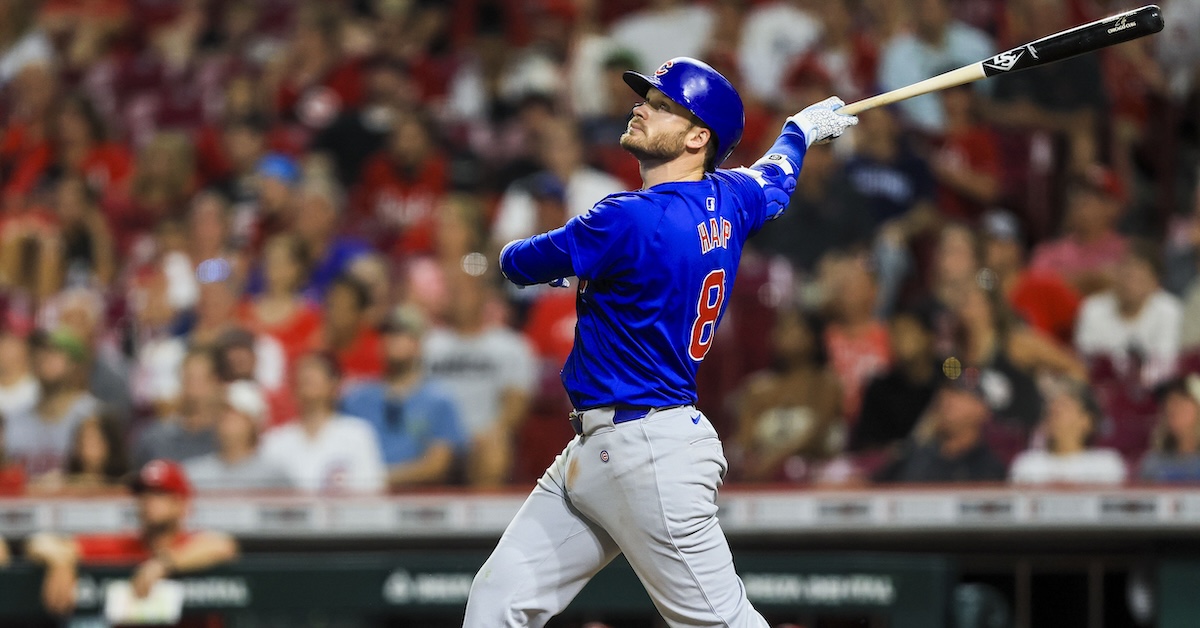Ian Happ Addresses His 2017 FanGraphs Scouting Report
The Chicago Cubs outfielder had a promising bat and questions about his defensive home.


Ian Happ’s defensive future was unclear when the Chicago Cubs made him a first-round pick in the 2015 draft. The sweet-swinging switch-hitter was selected as an outfielder, but he’d also played multiple infield positions during his three years at the University of Cincinnati. That uncertainty — fueled more by versatility than any serious shortcomings with the glove — remained when he was rated the Cubs’ no. 2 prospect in January 2017. While Eric Longenhagen opined that Happ’s most expedient path to the big leagues was as a left fielder, he nonetheless had him on our list as a second baseman. Either way, Happ’s calling card was going to be his bat. As our lead prospect analyst stated, “It profiles wherever he ends up playing.”
What did Happ’s 2017 scouting report look like? Moreover, what does he think of it all these years later? Wanting to find out, I shared some of what Eric wrote and asked Happ to respond to it.
———
“The Cubs drafted him ninth overall in a draft chock full of good college hitters up top despite questions about his ultimate defensive home.”
“There definitely were questions about my defensive home,” Happ said. “I’ve played seven positions in the big leagues, so while I ended up finding a home [in left field], I think it was an asset for me to be able to play a bunch of different spots — especially on those early teams with how many good players we had.
“We needed versatility in that group. We had Addison [Russell] playing shortstop. We had Javy [Báez], [Ben] Zobrist, Tommy La Stella, and myself at second. Kris Bryant was at third and [Anthony] Rizzo at first. In the outfield, we had [Kyle] Schwarber, [Albert] Almora, Jason Heyward, Jon Jay, Zobrist, and myself. We didn’t have a bunch of set positions, so to get in the lineup you had to hit, and you had to be versatile. That’s the way Joe Maddon ran teams over there. Had I been a one-position guy, I don’t know how much I would have played in the big leagues.”
“He’s an above-average straight-line runner with decent range and an above-average arm, but his actions and athleticism are not optimal for the infield.”
“I think that probably proved to be true,” Happ replied with a bemused expression. “I got to play a little bit of second base, but ultimately, with our lineup construction and who we had, I was never going to play second over Javy. Then Nico Hoerner came up in 2019, and he’s a Gold Glove defender. I was never going to be in the infield full time in Chicago.”
“Happ has plus bat speed and above-average power from both sides of the plate.”
“I don’t hate that,” Happ said. “I hit the ball hard. I think that tracks.”
“He has better bat control from the left side, but his discerning eye for the strike zone and patience allow him to get on base and tap into his power from the right side, even though he makes less contact.”
“That probably wasn’t… I don’t know what the numbers are overall, but there is probably more contact right-handed,” Happ responded. “Ball flight-wise, I get the ball in the air better left-handed than I do right-handed. But I think controlling the zone and being able to get on base sounds about right.”
“Happ’s barrel drags from the left side and he doesn’t always pull and demolish pitches that he should.”
“At that time, yeah, probably,” Happ said. “I was a high strikeout guy my first couple years and had to make a few adjustments, especially once the carry-four fastball came into play. Around 2017, 2018, 2019, I had to make some adjustments to be able to hit that pitch.
“Barrel dragging… that’s an interesting phrase. I don’t know exactly what that means, but my path wasn’t as direct as it is now. That’s why it was hard for me to hit four-seam fastballs early in my career. I hadn’t faced that type of velocity, hadn’t faced that type of pitch. Some of the elite closers in the game, like Trevor Rosenthal and guys who had really good carry-fours were a challenge for me. I hit sinkers and offspeed well, but I had to make some adjustments to be able to hit the higher-velocity, straight four-seam fastballs.”
“It’s an above-average hit, average game-power profile for me, which when supplemented by Happ’s ability to reach base via the walk and do some damage on the bases, plays as an above-average regular at either second or left.”
“Yeah, I guess so,” Happ said of Longenhagen’s synopsis. “I’ve been able to put together some good seasons, and I’m continuing to work at it. Man, it’s been a long time since I’ve thought about any of these [old scouting reports].”
——
Previous “Old Scouting Reports Revisited” interviews can be found through these links: Cody Bellinger, Dylan Cease, Matt Chapman, Jeff Hoffman.









